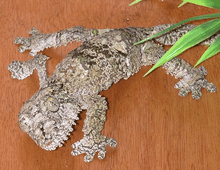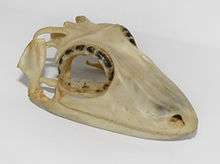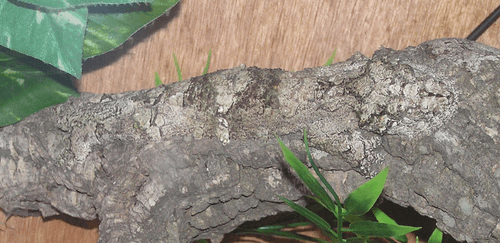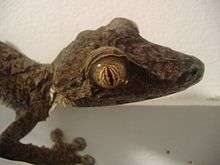Uroplatus
- For the Australian genera called leaf-tailed geckos, see Phyllurus, Saltuarius, and Orraya
| Uroplatus | |
|---|---|
 | |
| Uroplatus sikorae | |
| Scientific classification | |
| Kingdom: | Animalia |
| Phylum: | Chordata |
| Class: | Reptilia |
| Order: | Squamata |
| Family: | Gekkonidae |
| Subfamily: | Gekkoninae |
| Genus: | Uroplatus A.M.C. Duméril, 1806[1][2] |
| Species | |
|
17 recognized species, see article. | |
Uroplatus is a genus of geckos, commonly referred to as leaf-tail geckos or flat-tailed geckos, which are endemic to Madagascar and its coastal islands, such as Nosy Be. They are nocturnal, insectivorous lizards found exclusively in primary and secondary forest.
Etymology
The generic name, Uroplatus, is a Latinization of two Greek words: "ourá" (οὐρά) meaning "tail" and "platys" (πλατύς) meaning "flat".
Description
Geckos of the genus Uroplatus are nocturnal and arboreal. They range in total length (including tail) from about 30 cm (12 in) for U. giganteus to 10 cm (3.9 in) for U. ebenaui. Larger species of Uroplatus are distinguished among geckos in having the largest number of marginal teeth among all living amniotes. Other rare apomorphic character states include multiple inscriptional ribs, restriction of autotomy planes, and finger-like diverticula of the lungs.[3]

All Uroplatus species have highly cryptic colouration, which acts as camouflage, most being grayish-brown to black or greenish-brown with various markings resembling tree bark. There are two variations of this camouflage: leaf form, and bark form. The leaf form is present in a number of small-bodied species. All other forms blend in well with tree bark upon which they rest during the day. Some of these tree bark forms have developed a flap of skin, running the length of the body, known as a "dermal flap", which they lay against the tree during the day, scattering shadows, and making their outline practically invisible. These geckos bear a resemblance to geckos of the genera Phyllurus and Saltuarius of Australia. This is an example of convergent evolution.
The skull of Uroplatus is strongly ossified, with an extremely high tooth count and incipient secondary palate.[4]
Ecology

Uroplatus geckos are exclusively nocturnal. The larger species spend most of the daylight hours hanging vertically on tree trunks, head down, resting, while the smaller leaf tailed geckos (U. phantasticus, U. ebenaui, U. finiavana, U. malama, U. fiera, U. fotsivava, and U. kelirambo) spend more time in bushes and small trees imitating twigs and leaves. They are all insectivores.
During their breeding season, female Uroplatus lay from 2-4 eggs depending on species and conditions.
Captivity
Uroplatus are found in the herpetology and pet trade, but rarely. Most are threatened by deforestation and habitat loss. The difficulty in diagnosing between species has led to accidental exportation of both threatened and undescribed species.[5]
Threats
Habitat destruction and deforestation in Madagascar is the primary threat to the future of Uroplatus geckos as well as collection for the pet trade.[6] The World Wide Fund for Nature (WWF) lists all of the Uroplatus species on their "Top ten most wanted species list" of animals threatened by illegal wildlife trade, because of it "being captured and sold at alarming rates for the international pet trade". It is a CITES Appendix 2 protected animal.[6]
Taxonomy
The genus Uroplatus has had a complex taxonomic history. However, the most recent and detailed study suggests there are at least 11 undescribed cryptic species in the genus,[5] several of which have been described since its publication in 2013.[7][8]
Species
The following 17 species are recognised.[2]
- Uroplatus alluaudi Mocquard, 1894 – northern leaf-tail gecko
- Uroplatus ebenaui (Boettger, 1879) – spearpoint leaf-tail gecko
- Uroplatus fiera Ratsoavina, Ranjanaharisoa, Glaw, Raselimanana, Miralles & Vences, 2015
- Uroplatus fimbriatus (Schneider, 1792) – common leaf-tail gecko
- Uroplatus finiavana Ratsoavina, Louis, Crottini, Randrianiaina, Glaw & Vences, 2011
- Uroplatus fotsivava Ratsoavina, Gehring, Scherz, Vieites, Glaw, & Vences, 2017
- Uroplatus giganteus Glaw, Kosuch, Henkel, Sound & Böhme, 2006 – giant leaf-tail gecko
- Uroplatus guentheri Mocquard, 1908 – Günther's leaf-tail gecko
- Uroplatus henkeli Böhme & Ibisch, 1990 – frilled leaf-tail gecko
- Uroplatus kelirambo Ratsoavina, Fanomezana, Gehring, Scherz, Vieites, Glaw, & Vences, 2017
- Uroplatus lineatus (A.M.C. Duméril & Bibron, 1836) – lined leaf-tail gecko
- Uroplatus malahelo Nussbaum & Raxworthy, 1994
- Uroplatus malama Nussbaum & Raxworthy, 1995
- Uroplatus phantasticus (Boulenger, 1888) – satanic leaf-tail gecko
- Uroplatus pietschmanni Böhle & Schönecker, 2003 – cork-bark leaf-tail gecko
- Uroplatus sameiti Böhme & Ibisch, 1990
- Uroplatus sikorae Boettger, 1913 – mossy leaf-tail gecko
References
- ↑ ITIS (Integrated Taxonomic Information System). www.itis.gov.
- 1 2 The Reptile Database. www.reptile-database.org.
- ↑ Greenbaum, E.; Bauer, A.; Jackman, T.; Vences, M.; Glaw, F. (2007). "A phylogeny of the enigmatic Madagascan geckos of the genus Uroplatus". Zootaxa. Magnolia. 1493: 41–51.
- ↑ Darren Naish (18 May 2010). "The incredible leaf-tailed geckos (gekkotans part V)". ScienceBlogs. Retrieved 2 June 2015.
- 1 2 Ratsoavina, F. M.; Raminosoa, N. R.; Louis Jr., E. E.; Raselimanana, A. P.; Glaw, F.; Vences, M. (2013). "An overview of Madagascar's leaf tailed geckos (genus Uroplatus): species boundaries, candidate species, and review of geographical distribution based on molecular data". Salamandra. 49 (3): 115–148.
- 1 2 "Inclusion of Uroplatus spp. in Appendix II" (PDF). Technical comments in support of amendments to CITES appendices submitted by Madagascar. CITES. 2004. Archived from the original (pdf) on 23 November 2008. Retrieved 2 November 2008.
- ↑ Ratsoavina, Fanomezana Mihaja; Ranjanaharisoa, Fiadanantsoa Andrianja; Glaw, Frank; Raselimanana, Achille P.; Miralles, Aurélien; Vences, Miguel (2015-08-21). "A new leaf-tailed gecko of the Uroplatus ebenaui group (Squamata: Gekkonidae) from Madagascar's central eastern rainforests". Zootaxa. 4006 (1). doi:10.11646/zootaxa.4006.1.7. ISSN 1175-5334.
- ↑ Ratsoavina, Fanomezana M.; Gehring, Philip-Sebastian; Scherz, MarkD.; Vieites, David R.; Glaw, Frank; Vences, Miguel (2017-11-14). "Two new species of leaf-tailed geckos (Uroplatus) from the Tsaratanana mountain massif in northern Madagascar". Zootaxa. 4347 (3). doi:10.11646/zootaxa.4347.3.2. ISSN 1175-5334.
Further reading
- Duméril AMC. 1806. Zoologie analytique, ou méthode naturelle de classification des animaux, rendue plus facile a l'aide de tableux synoptiques. Paris: Allais. (Perronneau, printer). xxxii + 344 pp. (Uroplatus, new genus, p. 80). (in French).
External links
- Ratsoavina FM et al. 2011. A new leaf tailed gecko species from northern Madagascar with a preliminary assessment of molecular and morphological variability in the Uroplatus ebenaui group. Zootaxa 3022: 39–57. Preview
![]()
![]()
- Uroplatus geckos photo pool at Flickr, including these two pictures of the animal resting on tree trunks: and
- Uroplatus Information Centre containing details on taxonomy, morphology, ecology, and captive care of Uroplatus species.
- Watch more flat-tailed gecko (Uroplatus) video clips from the BBC archive on Wildlife Finder
- Unique video detailing typical satanic leaf tailed gecko chasing behaviour
